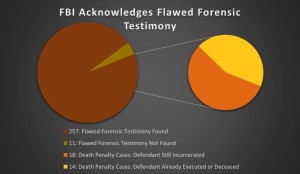On Sunday the FBI and the Justice Department released a statement acknowledging all except two of their microscopic hair comparison unit examiners overstated forensic matches in ways that favored the prosecution. This information comes as the National Association of Criminal Defense Lawyers (NACDL) and the Innocence Project assist the FBI in conducting a sweeping post-conviction review of forensic evidence. This extensive review began in 2012 following a Washington Post report “that flawed forensic hair matches might have led to the convictions of hundreds of potentially innocent people since at least the 1970s, typically for murder, rape and other violent crimes nationwide.”
So far, the NACDL and Innocence Project have reviewed 268 of roughly 2,500 cases in a 20-plus year period before 2000, in which the FBI lab reported a hair match. Of the 268 cases which have been reviewed, 257 are cases in which an FBI examiner gave flawed testimony; of these cases, there are 32 in which the defendant was sentenced to death (14 of these defendants were already been executed or died while in prison). Twenty-one of the identified cases are in Texas (all 5 of Texas’ death penalty defendants have been executed).
The FBI says it will wait until all of the identified cases have been reviewed before determining the cause of such widespread flawed evidence and seemingly-scientific testimony, but initially points to a lack of “written standards defining scientifically appropriate and erroneous ways to explain results in court.” Last year, the State of Texas (in conjunction with the Texas Innocence Project) was the first state to begin conducting post-conviction case reviews (Texas Forensic Science Commission Second Annual Report, see page 23) in which prosecutors relied on microscopic hair analysis.
However, this colossal question remains: Why was this allowed to happen in the first place?



